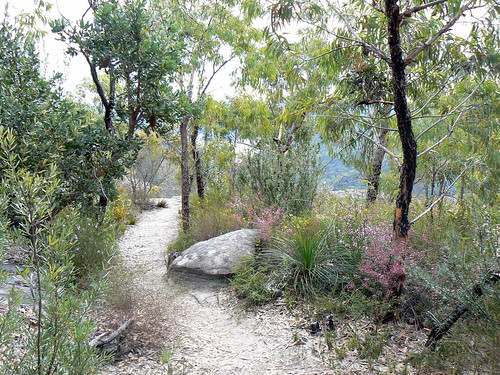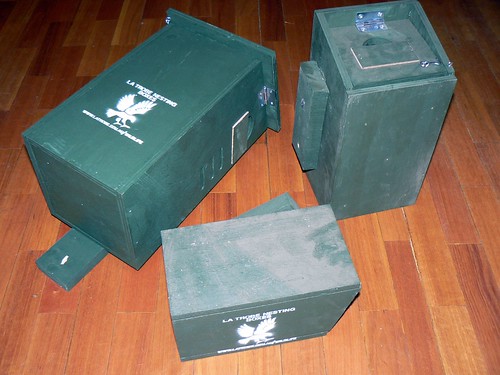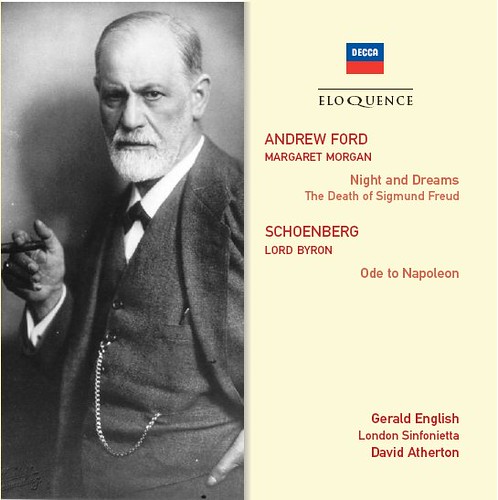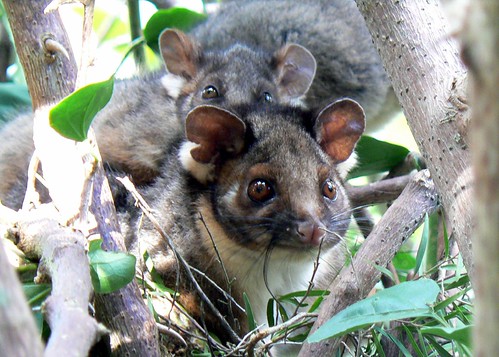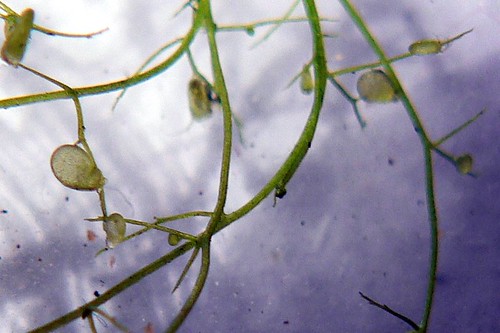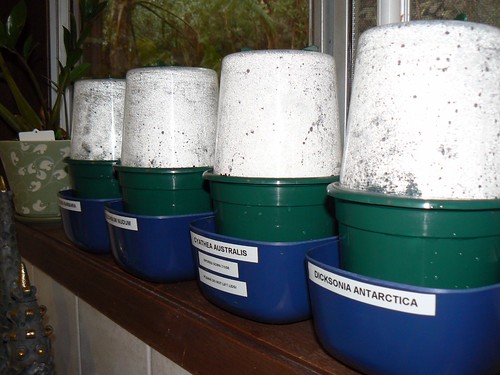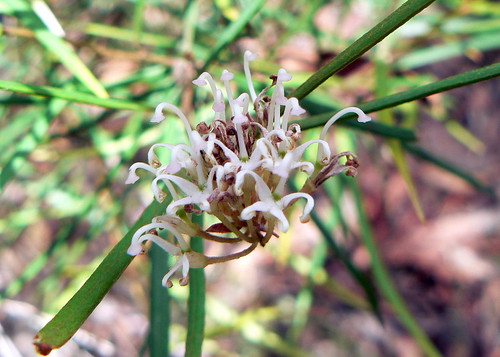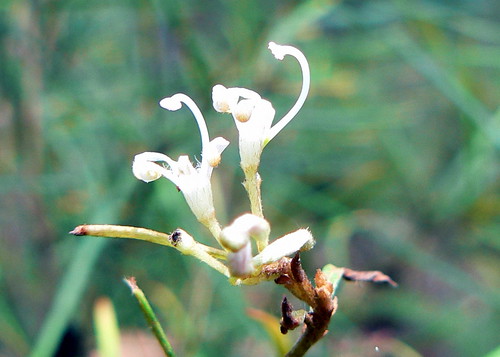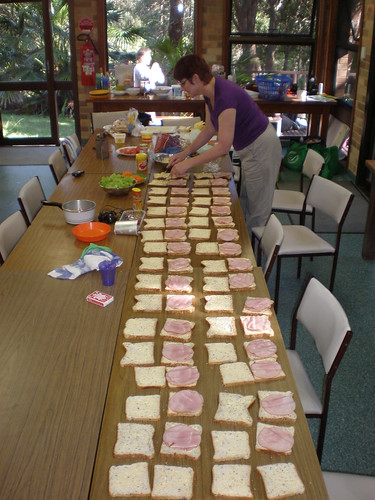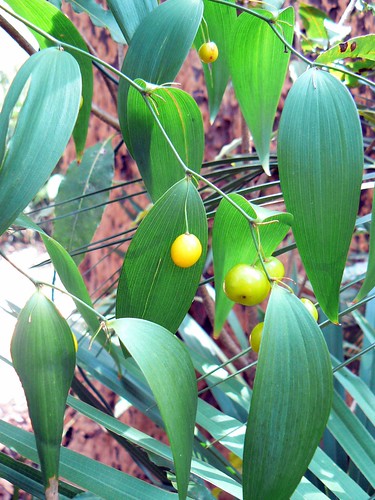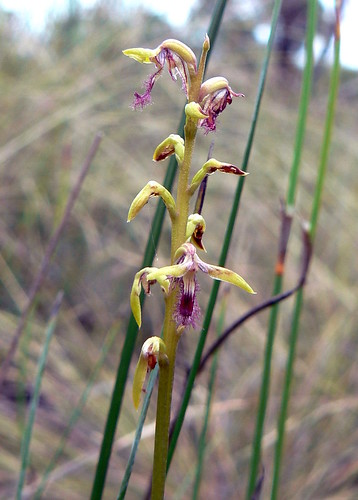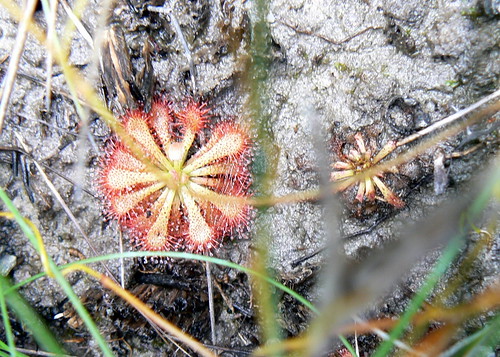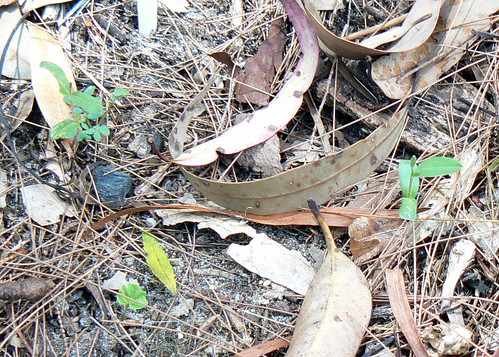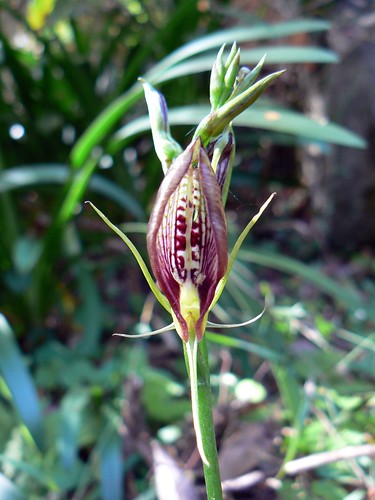Friday, December 05, 2008
Wednesday, November 05, 2008
Paul Ehrlich
Today was the inaugural Macquarie University Annual Evolution Lecture, given by Professor Paul Ehrlich, based on his latest book (co-authored by Anne Ehrlich), The Dominant Animal: Human Evolution and the Environment. It's an excellent innovation by the university, deliberately instigated to raise awareness of evolutionary theory and combat the force of darkness that is "intelligent design".
His excellent lecture--sobering yet entertaining--was recorded, so if a link becomes available I'll post it here.
He was introduced by former NSW Premier, Bob Carr.
Andy Beattie is a professor in biology at Macquarie University, and director of the Commonwealth Key Centre for Biodiversity and Bioresources, and co-author with Paul Ehrlich of Wild Solutions: How Biodiversity Is Money in the Bank.
Dave Briscoe is Head of the Biology Department at Macquarie. He was my first biology lecturer in my BSc, and has been amazingly supportive and encouraging of my studies. Unfortunately, Dave is retiring this year. He's a natural and inspiring teacher--so sad to see him leave.
And heck, Obama is going to be US President. Here's hoping the change we've been hearing about really happens. The world needs it, desperately.
His excellent lecture--sobering yet entertaining--was recorded, so if a link becomes available I'll post it here.
He was introduced by former NSW Premier, Bob Carr.
Paul Ehrlich (left) with Bob Carr.
From left to right: Professor Andy Beattie, Dr Anne Ehrlich,
Professor Dave Briscoe and Professor Ehrlich.
Professor Dave Briscoe and Professor Ehrlich.
Andy Beattie is a professor in biology at Macquarie University, and director of the Commonwealth Key Centre for Biodiversity and Bioresources, and co-author with Paul Ehrlich of Wild Solutions: How Biodiversity Is Money in the Bank.
Dave Briscoe is Head of the Biology Department at Macquarie. He was my first biology lecturer in my BSc, and has been amazingly supportive and encouraging of my studies. Unfortunately, Dave is retiring this year. He's a natural and inspiring teacher--so sad to see him leave.
And heck, Obama is going to be US President. Here's hoping the change we've been hearing about really happens. The world needs it, desperately.
If the world could vote....
...in the US elections. I know many of us think we should be able to, given the international stakes.
If you can't vote because of the trivial fact that you're not American, vote here:
http://www.iftheworldcouldvote.com/
The results thus far are perhaps unsurprising...
If you can't vote because of the trivial fact that you're not American, vote here:
http://www.iftheworldcouldvote.com/
The results thus far are perhaps unsurprising...
Sunday, October 26, 2008
Changes....
At the end of November, my contract with Australia's Virtual Herbarium at the National Herbarium of NSW expires as a result of that great constant in the world of science: funding running out. So I've been quietly hunting for new work, and verily, it has come to pass! Next year I'll be starting a job at Macquarie University as a part-time research assistant for six months or so, working with Associate Professor Brian Atwell of the Biology Department, who is doing research into Australian native rice (Oryza species).
It fits brilliantly with my plans: I'll be able to work in between lectures and pracs; it'll mean no more commuting to the city; it's hands-on work; it's potentially important research in terms of high protein crop development in a world of hungry people and changing climate; and best of all, I'll be doing Real Science!
But first, I have to finish this semester.... Exams loom. So excuse me if I continue to be a bit remiss in looking after this blog. See you when I come up for air again.
It fits brilliantly with my plans: I'll be able to work in between lectures and pracs; it'll mean no more commuting to the city; it's hands-on work; it's potentially important research in terms of high protein crop development in a world of hungry people and changing climate; and best of all, I'll be doing Real Science!
But first, I have to finish this semester.... Exams loom. So excuse me if I continue to be a bit remiss in looking after this blog. See you when I come up for air again.
Friday, September 05, 2008
Muogamarra Nature Reserve
I notice that I've been a bit lax with the blog again. For those twisted folk who come to read it, my apologies. But I've been busy on the side of the angels, working hard at university, up to my eyebrows in protein synthesis, stomatal guard cells and sexual self-incompatibility in plants (which I guess stops them from getting hairy palms).
Last weekend, we did take some time out, however, to spend a day walking in Muogamarra Nature Reserve, just north of here and just south of the Hawksbury River. Muogamarra is part of Ku-ring-gai Chase National Park, but a very special part. It's closed to the public all but 6 weekends of the year, in spring when the wild-flowers are at their most spectacular. A huge array of species, from Acacia, Grevillea, Boronia, Telopea, Bankia, and various pea flowers, all combining to create the most absurd display of colour.
I hope these images will give a sense of its magnificence.
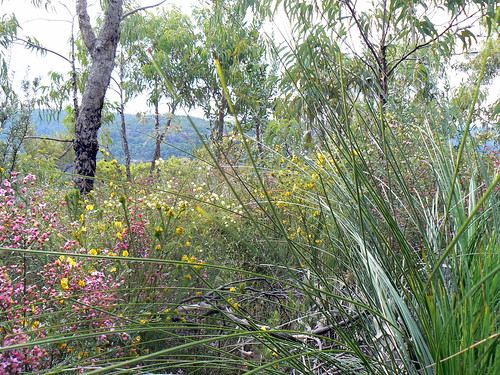
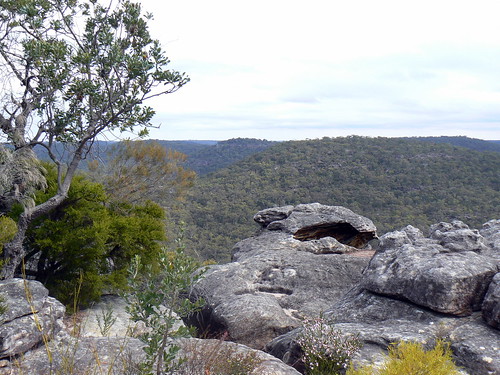
Last weekend, we did take some time out, however, to spend a day walking in Muogamarra Nature Reserve, just north of here and just south of the Hawksbury River. Muogamarra is part of Ku-ring-gai Chase National Park, but a very special part. It's closed to the public all but 6 weekends of the year, in spring when the wild-flowers are at their most spectacular. A huge array of species, from Acacia, Grevillea, Boronia, Telopea, Bankia, and various pea flowers, all combining to create the most absurd display of colour.
I hope these images will give a sense of its magnificence.


Wednesday, July 30, 2008
Birds!
For my birthday (Happy Birthday, me!) my parents gave me some money to spend as I wished, so I ordered three native bird nesting boxes from La Trobe University and they arrived today. Of course, there are plenty of tree hollows out in the National Park and we do have lots of birds visiting our garden, but I'm keen to have them nesting here so we can watch them.
One's for rosellas or lorikeets; one for large parrots; and one for pardalotes. The parrot boxes both have "exotic bird excluders", the thin pieces of wood partially covering the entrances. Parrots like to chew open entrances to their nests, while exotics can't, and won't fit in. The pardalote entrance is too tiny for other species.
These are the birds most likely to move in, just in case you're unfamiliar with them. I've seen all of them in our garden over the last year.


Yellow-tailed Black Cockatoo,
Calyptorhynchus funereus

One's for rosellas or lorikeets; one for large parrots; and one for pardalotes. The parrot boxes both have "exotic bird excluders", the thin pieces of wood partially covering the entrances. Parrots like to chew open entrances to their nests, while exotics can't, and won't fit in. The pardalote entrance is too tiny for other species.
These are the birds most likely to move in, just in case you're unfamiliar with them. I've seen all of them in our garden over the last year.



Yellow-tailed Black Cockatoo,
Calyptorhynchus funereus
Rainbow Lorikeet,
Trichoglossus haematodus
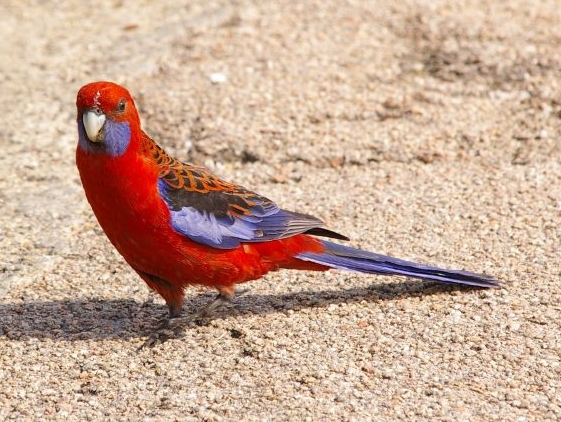
Crimson Rosella, Platycercus elegans

Trichoglossus haematodus

Crimson Rosella, Platycercus elegans

Eastern Rosella, Platycercus eximius
Bird images: Wikimedia Commons.
I'll post images of the boxes in situ, once we've done the ladder thing, and of course post updates when there's avian activity.
Bird images: Wikimedia Commons.
I'll post images of the boxes in situ, once we've done the ladder thing, and of course post updates when there's avian activity.
Sunday, July 27, 2008
Biodiversity
This clever image, "Species-scape", I found on one of my favourite blogs, Catalogue of Organisms (but it's also to be found here and here. I don't know who created the original.)
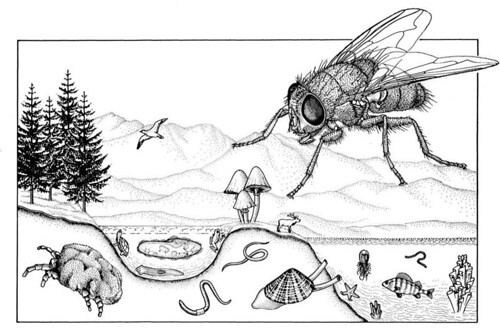

It's a graphical image of various groups of organisms represented at sizes relative to the number of described species in that group.
It reminds me of the delightful quotation attributed to J.B.S. Haldane: God, if he exists, has an inordinate fondness for beetles.
(While there are more arthropod species than species of other animals, within insects, there are more beetles than any other species. Sorry, fly. You must be in the graphic only because of your undoubted personal allure.)
It reminds me of the delightful quotation attributed to J.B.S. Haldane: God, if he exists, has an inordinate fondness for beetles.
(While there are more arthropod species than species of other animals, within insects, there are more beetles than any other species. Sorry, fly. You must be in the graphic only because of your undoubted personal allure.)
Wednesday, July 23, 2008
Terrarium
I've set up a little terrarium in an old aquarium--yes, also squeezed into the bathroom, along with the propagating ferns. There is something fascinating about them, the way they form microcosms. I've planted an Asplenium bulbiferum (hen and chicken fern, on the top left of this image) which grew from an adult plant in my garden, mosses, liverworts, lichens, and some Utricularia gibba in the "lake".
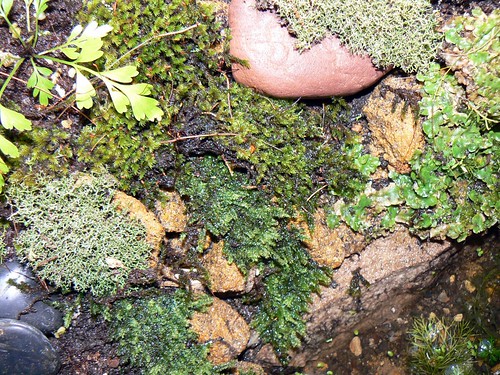

Incidentally, if you're interested in setting one up, there's a good trick to keep the water fresh. Before putting anything else in the tank, put in a layer of charcoal (best obtained from a aquarium shop and used for aquarium filters), then follow that with the sand, rocks, soil, etc. This limits the growth of anaerobic (ie, stinky) bacteria.
There. The perfect bathroom decoration. Better Homes and Gardens will be beating down my door.
There. The perfect bathroom decoration. Better Homes and Gardens will be beating down my door.
Thursday, July 17, 2008
Sigmund Freud, Ringtails and Mr Behemoth
I am feeling thoroughly guilty about having neglected my blog for so long. I plead work, uni exams, post-uni exams relaxation, and generalised pottering and time wasting. At least I'm feeling relaxed. (And my uni results have made me a very happy person! Biology is bliss.)
A couple of bits of news. Firstly, I have a CD coming out this month. It's from my previous incarnation as a playwright/librettist. The last major work I wrote (with composer Andrew Ford) was "Night and Dreams: the death of Sigmund Freud", which toured the Sydney, Melbourne and Adelaide Festivals earlier this decade, performed by tenor Gerald English. ABC Classic FM made a studio recording, and now it's being released by Decca. You can read about the piece here and see the nice things the press said here.
If you happen to want to buy the CD, you can order it from Buywell Just Classical.
Also, I'd like to introduce you to a friend of mine, if you're unfamiliar with his work. Ben Popjie (aka Mr Behemoth) is a Melbourne writer and comedian with a fine line in brutal and well-wrought satire. He's started a new blog on Blogspot: Ben Pobjie's Wonderful World of Objects and also writes a weekly column for New Matilda. Ben's wit regularly has me chortling, and his political perspectives are astute.
And just to ensure that I'm not entirely off-topic with this post, a photo of a family of ringtail possums that lives just outside our back door. I took this photo after my husband attempted to remove the bougainvillea growing there (a non-native plant... pffft), without our realising that they had begun building a drey in it. They were indignant, as you can see. Needless to say, the bougainvillea is staying.
A couple of bits of news. Firstly, I have a CD coming out this month. It's from my previous incarnation as a playwright/librettist. The last major work I wrote (with composer Andrew Ford) was "Night and Dreams: the death of Sigmund Freud", which toured the Sydney, Melbourne and Adelaide Festivals earlier this decade, performed by tenor Gerald English. ABC Classic FM made a studio recording, and now it's being released by Decca. You can read about the piece here and see the nice things the press said here.
If you happen to want to buy the CD, you can order it from Buywell Just Classical.
Also, I'd like to introduce you to a friend of mine, if you're unfamiliar with his work. Ben Popjie (aka Mr Behemoth) is a Melbourne writer and comedian with a fine line in brutal and well-wrought satire. He's started a new blog on Blogspot: Ben Pobjie's Wonderful World of Objects and also writes a weekly column for New Matilda. Ben's wit regularly has me chortling, and his political perspectives are astute.
And just to ensure that I'm not entirely off-topic with this post, a photo of a family of ringtail possums that lives just outside our back door. I took this photo after my husband attempted to remove the bougainvillea growing there (a non-native plant... pffft), without our realising that they had begun building a drey in it. They were indignant, as you can see. Needless to say, the bougainvillea is staying.
Sunday, April 13, 2008
Earth Stars

These fungi, Earth Stars, are of the genus Geastrum. They popped up in our garden this week. It's a fine time of year for fungi at the moment. We've counted ten or so different species within a few square metres of our front door.
The star-like structure at the base of the fruiting body originally covered the ball, but then splits open. It's a type of puffball. The ball holds the spores, and when disturbed, puffs out a mist of spores through the central pore.
I've not been posting much--or at all!--lately, because I've been hugely busy with work, study and familish stuff. Uni is going really well. I'm just loving biology to pieces. I feel like I've come home.
Saturday, March 01, 2008
Utricularia gibba ssp. exoleta
I collected some Utricularia gibba ssp. exoleta--Floating Bladderwort--from a dam in Wyee on the NSW Central Coast over a year ago, and have been cultivating it in an open fish-tank in the back garden ever since. Looking at the bladders under the microscope is a wonderful experience, because they're such delicate and efficient structures. They open and draw in some of the surrounding water, then close again to digest the tiny microscopic creatures sucked in with the water. Thus, they're carnivorous plants, but very different from more famous carnivores like the Dionaea muscipula , the Venus Fly Trap.
While I was looking at some today, I found myself wishing that I had a camera attachment for my microscope, and then wondered how it would turn out just with regular macro photography. Quite well, it transpires!
The "stems" are actually stolons, the "shoots" from the stolons are modified leaves, and the bladders grow off the leaves.
To give you a sense of scale, the bladders (or traps) are only 1 to 2.5 mm long.
While I was looking at some today, I found myself wishing that I had a camera attachment for my microscope, and then wondered how it would turn out just with regular macro photography. Quite well, it transpires!
The "stems" are actually stolons, the "shoots" from the stolons are modified leaves, and the bladders grow off the leaves.
To give you a sense of scale, the bladders (or traps) are only 1 to 2.5 mm long.
Monday, February 25, 2008
Tinkering.
I've been playing around with templates for my blog. One of the lovely things about Blogspot is that nice people design blog templates and you can adopt them. This one I like because it's wider than most, so I don't have to squish my photos quite as much.
The new image at the top of the screen is a photo I took at the Herbarium of a moss specimen, Hypnodenron comosum, collected in Tasmania in 1985. Here's a more complete image:
The diversity of mosses is quite stunning. Some look like miniature palms, some like ferns, some like turf. Even dried out and ancient, they can be strikingly beautiful.
The new image at the top of the screen is a photo I took at the Herbarium of a moss specimen, Hypnodenron comosum, collected in Tasmania in 1985. Here's a more complete image:
The diversity of mosses is quite stunning. Some look like miniature palms, some like ferns, some like turf. Even dried out and ancient, they can be strikingly beautiful.
Sunday, February 24, 2008
2008 Plant Science Internship Graduation.
On Friday, the Interns completed their Plant Science Program. They were just as enthused as we were this time last year.
The Media Release from the Gardens:
A group of 10 plant scientists of the future have been trained by Australia’s best, while at the same time helping to collect, study and record plant species for the National Herbarium of NSW.
Botanic Gardens Trust Executive Director Dr Tim Entwisle will present completion certificates to students of its 2008 Plant Science Internship Program today and thank them for their contribution.
“This work experience was very hands-on; the students contributed a great deal to our scientific study of plant species. Their efforts included helping us to re-organise the Herbarium in accordance with the latest DNA studies,” Dr Entwisle said.
“DNA sequencing has opened up amazing opportunites for the Botanic Gardens. While students identified plants using books and the internet, their efforts will help us create a DNA barcoding system that will contribute to the goal of eventually identifying every plant on the planet.
“Plant DNA barcoding will one day be a simple ‘black box’ method for distinguishing one species from another. For example, it will be used to quickly inventory biodiversity in a protected area or to monitor shipments of plants for illegal trading and endangered species,” he said.
“To bring this project to fruition, we need high quality science to first describe and classify the things we want to identify. There are still lots of flowering plants, and probably many thousands of algae and fungi yet to be discovered, let alone described and classified,” he said. “There is work to be done and these new scientists are already making a major contribution.”
The NSW-based science students who currently study related topics at universities and TAFE’s, gave up their summer holiday period to take part in the seven week 2008 Plant Science Internship program which is largely funded by the Friends of the Gardens for the Botanic Gardens Trust.
Coordinator of the Intern program, Bob Makinson said the students were shown a wide range of plant communities on the Central Coast.
“During the program, we discussed the management implications of the areas we visited, with guest speakers from the National Parks and Wildlife Division of the Department of Environment and Climate Change,” Mr Makinson said.
“The interns also contributed greatly to maintaining the Herbarium’s collections. The purpose of the NSW Herbarium is to know and record everything about the Flora of NSW and nationally. Plants are also collected from South West Pacific and South East Asia.
“In the last four weeks of our 2008 Intern program, the really important work began. This is when the students were allotted tasks and work with science staff on research projects, he said.
As a going away present, one of the Amorphophallus titanum (Titan Arum or Corpse plant) growing in the Garden's Tropical Centre decided to flower for them, a rare but spectacular event:
On far right: Dr Tim Entwistle, Executive Director of the Botanic Gardens.
Sixth from right: Caro Webster, President of the Friends of the Gardens.
Sixth from right: Caro Webster, President of the Friends of the Gardens.
The Media Release from the Gardens:
The science of plants opens new doors
A group of 10 plant scientists of the future have been trained by Australia’s best, while at the same time helping to collect, study and record plant species for the National Herbarium of NSW.
Botanic Gardens Trust Executive Director Dr Tim Entwisle will present completion certificates to students of its 2008 Plant Science Internship Program today and thank them for their contribution.
“This work experience was very hands-on; the students contributed a great deal to our scientific study of plant species. Their efforts included helping us to re-organise the Herbarium in accordance with the latest DNA studies,” Dr Entwisle said.
“DNA sequencing has opened up amazing opportunites for the Botanic Gardens. While students identified plants using books and the internet, their efforts will help us create a DNA barcoding system that will contribute to the goal of eventually identifying every plant on the planet.
“Plant DNA barcoding will one day be a simple ‘black box’ method for distinguishing one species from another. For example, it will be used to quickly inventory biodiversity in a protected area or to monitor shipments of plants for illegal trading and endangered species,” he said.
“To bring this project to fruition, we need high quality science to first describe and classify the things we want to identify. There are still lots of flowering plants, and probably many thousands of algae and fungi yet to be discovered, let alone described and classified,” he said. “There is work to be done and these new scientists are already making a major contribution.”
The NSW-based science students who currently study related topics at universities and TAFE’s, gave up their summer holiday period to take part in the seven week 2008 Plant Science Internship program which is largely funded by the Friends of the Gardens for the Botanic Gardens Trust.
Coordinator of the Intern program, Bob Makinson said the students were shown a wide range of plant communities on the Central Coast.
“During the program, we discussed the management implications of the areas we visited, with guest speakers from the National Parks and Wildlife Division of the Department of Environment and Climate Change,” Mr Makinson said.
“The interns also contributed greatly to maintaining the Herbarium’s collections. The purpose of the NSW Herbarium is to know and record everything about the Flora of NSW and nationally. Plants are also collected from South West Pacific and South East Asia.
“In the last four weeks of our 2008 Intern program, the really important work began. This is when the students were allotted tasks and work with science staff on research projects, he said.
As a going away present, one of the Amorphophallus titanum (Titan Arum or Corpse plant) growing in the Garden's Tropical Centre decided to flower for them, a rare but spectacular event:
The reason the plant is draped in black fabric is that the Tropical Centre staff are taking time-lapse photos of it as it opens. Once the flower develops, it grows remarkably quickly--around 10 centimetres a day. I took this photo on Friday, but by now it will have opened, revealing exactly why it's called a corpse plant. It emits a foul odour to attract pollinators that consume dead flesh.
The dimensions of a mature Amorphophallus titanum, from the Gardens' Fact Sheet.
spadix — 2 to 2.9 metres (7 to 12 feet)
leaf height — 6 metres (20 feet)
leaf width — 4.5 metres (15 feet)
tuber (corm) — 100 kilograms (220 pounds)
Boggling, all in all!
The dimensions of a mature Amorphophallus titanum, from the Gardens' Fact Sheet.
spadix — 2 to 2.9 metres (7 to 12 feet)
leaf height — 6 metres (20 feet)
leaf width — 4.5 metres (15 feet)
tuber (corm) — 100 kilograms (220 pounds)
Boggling, all in all!
Tuesday, February 19, 2008
A Room of One's Own.
Virginia Woolf wrote about it nearly a century ago: the importance of having a room of one's own. She was writing specifically for women, who rarely had such a luxury at the time. Perhaps too few of us have one still.
But I do. I now have the room I've dreamed of for years. I have my books, some beautiful furniture, prints on the wall, plants, my desk, my computer (sorry Virginia, a bit of a shock, I imagine), my music and my microscopes surrounding me. I have a place I love, a place of stillness to allow thought and ideas and study.
I won't post the rest of the photos of the transformation and the (almost--a rug and curtains remain to be furnished) finished product, but you can see the slideshow here. (Put your cursor on the first photo and click on the i, to get my comments.)
Happily yours,
M.
But I do. I now have the room I've dreamed of for years. I have my books, some beautiful furniture, prints on the wall, plants, my desk, my computer (sorry Virginia, a bit of a shock, I imagine), my music and my microscopes surrounding me. I have a place I love, a place of stillness to allow thought and ideas and study.
I won't post the rest of the photos of the transformation and the (almost--a rug and curtains remain to be furnished) finished product, but you can see the slideshow here. (Put your cursor on the first photo and click on the i, to get my comments.)
Happily yours,
M.
Saturday, February 09, 2008
Where in the Gardening World are YOU?
This is a question being asked of gardening bloggers across the world by Blooming Writer. So I thought I'd join the fray.
I am on the northern outskirts of Sydney, in the botanical district of Australia's NSW Central Coast. It's a temperate climate here, not too hot, not too cold. For certain definitions of hot and cold that is.... I consider below 15C to be too cold, and over 30C to be too hot. As with most of the continent, I live in place of droughts and flooding rains...
My garden might have no rain for months, but then be inundated, as it is being currently, with close to 200 mm over the last few weeks. Sydney doesn't do rain gently. When it rains, it buckets down, often with furious electrical storms. Having trees fall over is commonplace here.
As is, alas, bushfire. When we bought this place a year ago, the beautiful bushland of Ku-ring-gai National Park at our back boundary was blackened. Terrifying, disheartening. But now, it's green again. For this flora is evolved to live with fire. Indeed, without fire, much of it cannot regenerate. It's a tough environment and one that non-Indigenous Australians are only lately coming to adapt to.
So, my garden? Well, it's only recently mine. I am so aware of its longevity. White folk moved here only around 150 years ago. There are trees in the garden that well predate European colonisation. Along the side of the house is an Aboriginal shell midden. That this land was taken from Aborigines quite recently--we are talking, after all, about a culture that has existed for around 60,000 years, longer than any other continuous culture on the planet--that this land that owned them is something that we now "own", is something that constantly resonates with me and informs me as I till the soil.
When we moved in, there were many introduced species, some of which were frankly weedy. But of course, what is weedy to an Australian botanist/ecologist/horticulturist is a lovely and easy to grow plant to your average gardener. The latter is an attitude that is changing, but too slowly. I was deeply affronted that anyone who chose to live in a house adjoining one of Australia's most remarkable national parks could contemplate planting things from the other side of the world, but there you are. I guess they didn't know about the propensity of introduced plants to escape and naturalise. Or, more baffling to comprehend, they didn't care.
And so, finally, to what I'm doing in this place. First and foremost, I'm removing the exotics. I'm not doing this as quickly as I'd like, because if I took out all the Camellias, we'd lose a lot of our privacy. (This just boils my blood. The previous owners apparently removed the rows of lillipillies along the driveway--probably Acmena smithii--and replaced them with Camellias. Why, I'll never know. The lillipillies were home to ring-tail possums. The Camillias are home to nothing but invasive Noisy Miners. An example of their intrusion elsewhere in Australia is here.)
And more bloody agapanthus than you could poke a stick at. They're horrors to remove, and seriously invasive in bushland adjoining suburban regions.
Okay, I'm letting my passion get away with me here. Back on topic...! Removing the weedy plants allows the seedbank in the soil to have a chance. So I'm doing a lot of that. And I'm planting many indigenous species, some of which I'm propagating myself. My goal is, essentially, to reproduce the original bushland, but to mold and sculpt it to my vision of garden beauty. I love semi-formal gardens. Structure, but not to the point of squishing the nature out of nature.
It's a very long term plan. Some of the trees I've planted won't reach maturity till long after I'm gone, but that's part of the joy of gardening.
As Vita Sackville-West wrote, "Gardening is a way of showing that you believe in tomorrow." It doesn't really matter if you won't be there tomorrow. The plants will.
I am on the northern outskirts of Sydney, in the botanical district of Australia's NSW Central Coast. It's a temperate climate here, not too hot, not too cold. For certain definitions of hot and cold that is.... I consider below 15C to be too cold, and over 30C to be too hot. As with most of the continent, I live in place of droughts and flooding rains...
-
- I love a sunburnt country,
- A land of sweeping plains,
- Of ragged mountain ranges,
- Of droughts and flooding rains.
- I love her far horizons,
- I love her jewel-sea,
- Her beauty and her terror
- The wide brown land for me!
My garden might have no rain for months, but then be inundated, as it is being currently, with close to 200 mm over the last few weeks. Sydney doesn't do rain gently. When it rains, it buckets down, often with furious electrical storms. Having trees fall over is commonplace here.
As is, alas, bushfire. When we bought this place a year ago, the beautiful bushland of Ku-ring-gai National Park at our back boundary was blackened. Terrifying, disheartening. But now, it's green again. For this flora is evolved to live with fire. Indeed, without fire, much of it cannot regenerate. It's a tough environment and one that non-Indigenous Australians are only lately coming to adapt to.
So, my garden? Well, it's only recently mine. I am so aware of its longevity. White folk moved here only around 150 years ago. There are trees in the garden that well predate European colonisation. Along the side of the house is an Aboriginal shell midden. That this land was taken from Aborigines quite recently--we are talking, after all, about a culture that has existed for around 60,000 years, longer than any other continuous culture on the planet--that this land that owned them is something that we now "own", is something that constantly resonates with me and informs me as I till the soil.
When we moved in, there were many introduced species, some of which were frankly weedy. But of course, what is weedy to an Australian botanist/ecologist/horticulturist is a lovely and easy to grow plant to your average gardener. The latter is an attitude that is changing, but too slowly. I was deeply affronted that anyone who chose to live in a house adjoining one of Australia's most remarkable national parks could contemplate planting things from the other side of the world, but there you are. I guess they didn't know about the propensity of introduced plants to escape and naturalise. Or, more baffling to comprehend, they didn't care.
And so, finally, to what I'm doing in this place. First and foremost, I'm removing the exotics. I'm not doing this as quickly as I'd like, because if I took out all the Camellias, we'd lose a lot of our privacy. (This just boils my blood. The previous owners apparently removed the rows of lillipillies along the driveway--probably Acmena smithii--and replaced them with Camellias. Why, I'll never know. The lillipillies were home to ring-tail possums. The Camillias are home to nothing but invasive Noisy Miners. An example of their intrusion elsewhere in Australia is here.)
And more bloody agapanthus than you could poke a stick at. They're horrors to remove, and seriously invasive in bushland adjoining suburban regions.
Okay, I'm letting my passion get away with me here. Back on topic...! Removing the weedy plants allows the seedbank in the soil to have a chance. So I'm doing a lot of that. And I'm planting many indigenous species, some of which I'm propagating myself. My goal is, essentially, to reproduce the original bushland, but to mold and sculpt it to my vision of garden beauty. I love semi-formal gardens. Structure, but not to the point of squishing the nature out of nature.
It's a very long term plan. Some of the trees I've planted won't reach maturity till long after I'm gone, but that's part of the joy of gardening.
As Vita Sackville-West wrote, "Gardening is a way of showing that you believe in tomorrow." It doesn't really matter if you won't be there tomorrow. The plants will.
Thursday, February 07, 2008
Fern Propagation
I've started up some fern propagation in my bathroom along the window ledge. It's brightly lit and warm there but at this time of year it gets no direct sunlight, which is pretty much ideal.
The spores I've sown are of:
Dicksonia antarctica Soft Tree Fern, grows to 4.5 m high.
Cyathea australis Rough Tree Fern, grows to 20 m high.
Blechnum nudum Fishbone Water Fern, trunk to 1 m.
Todea barbara King Fern, trunk to 3 m, fronds to 2.5 m.
All are indigenous to my region. It's a long and tricky process to grow ferns from spores, and I've not succeeded in the past--probably because I let the medium dry out. If this lot make it, it'll be decades before they reach full size.
Here's the procedure:
 Image source: http://www.anbg.gov.au/ferns/fern.cycle.gif
Image source: http://www.anbg.gov.au/ferns/fern.cycle.gif
Australian National Botanic Gardens.
Illustration by Murray Fagg ©
As you can see from this diagram, the reproductive cycle of ferns is fascinating. It essentially has two generations that alternate, one being being gamete producing and the other spore producing.
The spore germinates to form a prothallus, a green speck only a cell thick in places, on the surface of the medium. It contains both male and female sex organs, and the male sperm fertilises the female egg and the new fern then grows out of the prothallus.
The spores I've sown are of:
Dicksonia antarctica Soft Tree Fern, grows to 4.5 m high.
Cyathea australis Rough Tree Fern, grows to 20 m high.
Blechnum nudum Fishbone Water Fern, trunk to 1 m.
Todea barbara King Fern, trunk to 3 m, fronds to 2.5 m.
All are indigenous to my region. It's a long and tricky process to grow ferns from spores, and I've not succeeded in the past--probably because I let the medium dry out. If this lot make it, it'll be decades before they reach full size.
Here's the procedure:
- You can obtain spores by collecting fronds with well-developed sori, and place them face down on a sheet of paper in a place where draughts won't blow them away. The spores, which are are tiny and resemble fine dust, will fall out onto the paper over a few hours providing the sori are ripe.
- Sterilise all pots, lids and saucers (I've used bowls). You can do this with boiling water, but try to avoid getting them contaminated while they're drying. I used a clean tea towel to sit them on.
- Prepare your growing medium. I've used peat moss which I bought in a block and to which I added boiling water, to sterilise and hydrate it. You can also use sphagnam moss
- Add the growing medium to the pots, and cover as soon as possible. You don't want bacteria or spores from fungi contaminating the material. If you don't have propagation pots with lids like those above, you can cover the pots with glass or clear plastic film.
- Sit the pots into their saucers or bowls and water into saucer/bowl, partly submerging the pot.
- When the pots have cooled down, remove the lids one by one and sprinkle on the spores. Cover again immediately.
- Make sure that the medium doesn't dry out--keep your eye on the water levels!
 Image source: http://www.anbg.gov.au/ferns/fern.cycle.gif
Image source: http://www.anbg.gov.au/ferns/fern.cycle.gifAustralian National Botanic Gardens.
Illustration by Murray Fagg ©
The spore germinates to form a prothallus, a green speck only a cell thick in places, on the surface of the medium. It contains both male and female sex organs, and the male sperm fertilises the female egg and the new fern then grows out of the prothallus.
- While the prothallus develops over the next 6 to 12 months, it's important not to allow any contamination to occur, so continue to water from below.
- Once the ferns (fernlings?) emerge, you can start watering from above, using a mister or fine water sprayer. Again, only remove the lid briefly.
- When a few fronds have appeared, you can prick the ferns out to avoid overcrowding, moving them into more pots and slowly hardening them off by gradually exposing them to the air. Keep them out of direct sunlight.
Sunday, February 03, 2008
Central Coast Field Trip: Strickland State Forest
Strickland State Forest encompasses an extraordinarily diverse environment, ranging from dry sclerophyll forest, to heathland, to lush temperate rainforest, and is home to a range of endangered and rare plant species. MAP
Last year we visited the rainforest and I have never seen more leeches in my life (and that's including my front garden!) so while the interns and a few members of staff walked down to the creek, I lingered near the vehicles and took photos. Bob Makinson, one of my colleagues and the coordinator of the Centre for Plant Conservation at the Herbarium, is one of the world's foremost experts on the Grevillea genus. We have plans to collaborate on an ID CD, so he and I set forth in search of some specimens to photograph, specifically Grevillea linearifolia and Grevillea oldei. Bob has identified a possible subspecies of the former, and plans further investigation to see if a taxonomic change is warranted.
Here is the inflorescence:
And some single flowers:
The Grevillea oldei flower is difficult to photograph in situ because of its habit (pun intended!) of hanging low to the ground. I took this image by lying with my chin on the dirt.
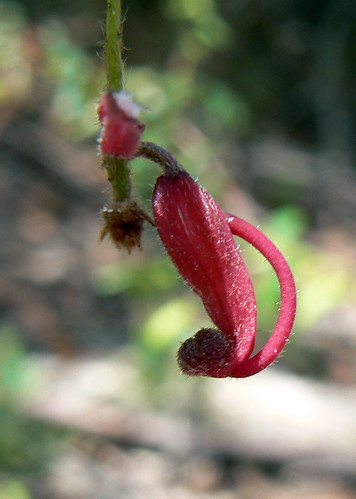
Last year we visited the rainforest and I have never seen more leeches in my life (and that's including my front garden!) so while the interns and a few members of staff walked down to the creek, I lingered near the vehicles and took photos. Bob Makinson, one of my colleagues and the coordinator of the Centre for Plant Conservation at the Herbarium, is one of the world's foremost experts on the Grevillea genus. We have plans to collaborate on an ID CD, so he and I set forth in search of some specimens to photograph, specifically Grevillea linearifolia and Grevillea oldei. Bob has identified a possible subspecies of the former, and plans further investigation to see if a taxonomic change is warranted.
Here is the inflorescence:
And some single flowers:
The Grevillea oldei flower is difficult to photograph in situ because of its habit (pun intended!) of hanging low to the ground. I took this image by lying with my chin on the dirt.

This shot required rather less in the way of contortionism:


Nothing at all to do with Grevillea is this gorgeous little fern that caught my eye, Schizaea bifida:
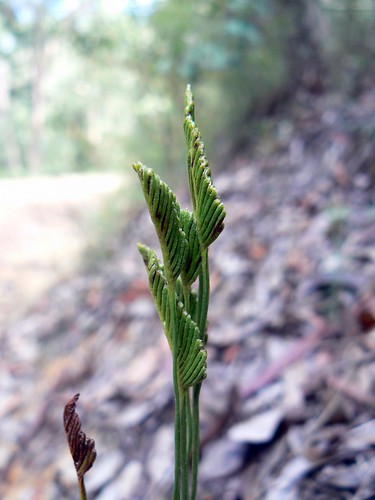

What a honey. I'd love one in my garden. I really need to work on my fern propagation skills....
The interns emerge from the rainforest. Because we're lovely people, we'd driven the vehicles down to pick them up....
The interns emerge from the rainforest. Because we're lovely people, we'd driven the vehicles down to pick them up....
Monday, January 28, 2008
Central Coast Field Trip: the Recipes
Me making sandwiches for the interns' lunch in the field....
There have been a couple of requests for the recipes of some of the food I prepared for the field trip, so I'll post them here. Rather than give the quantities for 20 people, which no one in their right mind could possibly want (!), these are for four servings.
There have been a couple of requests for the recipes of some of the food I prepared for the field trip, so I'll post them here. Rather than give the quantities for 20 people, which no one in their right mind could possibly want (!), these are for four servings.
Vegie Curry
Ingredients:
Sauce (can be made ahead, can be frozen. Make lots to feed your curry habit!):
50 grams ghee
2 onions, chopped
1 bottle of passata
8 cloves garlic, crushed
Around the same quantity of fresh ginger, finely chopped
1 teaspoon cumin
1 teaspoon turmeric
1 teaspoon ground coriander seed
Olive oil
Vegies:
2 sticks celery, chopped
4 potatoes chopped into bite-sized pieces
1/2 head of cauliflower, chopped into bite-sized pieces
2 medium-sized eggplants
1 sweet potato, chopped into bite-sized pieces
Bunch fresh coriander
Method:
Sauce:
1. Heat oil in a heavy based saucepan. Add onion and stir on medium-low heat till translucent--around ten minutes.
2. Add ginger and garlic and cook for another couple of minutes. Reduce heat.
3. Add cumin, turmeric and coriander seed and cook gently for five minutes being careful not to let it catch.
4. Remove from heat, add 250 mls water and allow to cool for a few minutes. Put into food processor and blend till smooth.
5. Return to saucepan and add passata, stir. Cook on low heat for 30 minutes, stirring regularly to avoid it catching.
Meanwhile....
Vegies:
Peel and chop the eggplant into 1 cm cubes. Sprinkle with salt and set aside in a bowl. Leave for around 15 minutes, then rinse in cold water and dry on paper towels.
Put all vegetables into a pot of salted, boiling water, and parboil.
Drain when the vegies are softening slightly, and add the sauce. You might need to add a little more water at this point. Use some of the water you've used for the vegies.
Cook the lot on a low heat for around an hour, or until the vegetables are cooked. Add water as required.
Serve with Basmati rice, Indian pickles and chutneys, raita (yoghurt with cumin and chopped cucumber) and sprinkle with freshly chopped coriander leaves.
If you'd like a little flesh in your curry, chop up a couple of chicken thigh fillets, brown in oil, and add when you add the sauce to the vegetables.
A nice tip I picked up from a friend is to wrap leftover curry in filo pastry, and bake to make a version of samosas. I'm going to try that soon!
Sauce (can be made ahead, can be frozen. Make lots to feed your curry habit!):
50 grams ghee
2 onions, chopped
1 bottle of passata
8 cloves garlic, crushed
Around the same quantity of fresh ginger, finely chopped
1 teaspoon cumin
1 teaspoon turmeric
1 teaspoon ground coriander seed
Olive oil
Vegies:
2 sticks celery, chopped
4 potatoes chopped into bite-sized pieces
1/2 head of cauliflower, chopped into bite-sized pieces
2 medium-sized eggplants
1 sweet potato, chopped into bite-sized pieces
Bunch fresh coriander
Method:
Sauce:
1. Heat oil in a heavy based saucepan. Add onion and stir on medium-low heat till translucent--around ten minutes.
2. Add ginger and garlic and cook for another couple of minutes. Reduce heat.
3. Add cumin, turmeric and coriander seed and cook gently for five minutes being careful not to let it catch.
4. Remove from heat, add 250 mls water and allow to cool for a few minutes. Put into food processor and blend till smooth.
5. Return to saucepan and add passata, stir. Cook on low heat for 30 minutes, stirring regularly to avoid it catching.
Meanwhile....
Vegies:
Peel and chop the eggplant into 1 cm cubes. Sprinkle with salt and set aside in a bowl. Leave for around 15 minutes, then rinse in cold water and dry on paper towels.
Put all vegetables into a pot of salted, boiling water, and parboil.
Drain when the vegies are softening slightly, and add the sauce. You might need to add a little more water at this point. Use some of the water you've used for the vegies.
Cook the lot on a low heat for around an hour, or until the vegetables are cooked. Add water as required.
Serve with Basmati rice, Indian pickles and chutneys, raita (yoghurt with cumin and chopped cucumber) and sprinkle with freshly chopped coriander leaves.
If you'd like a little flesh in your curry, chop up a couple of chicken thigh fillets, brown in oil, and add when you add the sauce to the vegetables.
A nice tip I picked up from a friend is to wrap leftover curry in filo pastry, and bake to make a version of samosas. I'm going to try that soon!
Pesto Chicken with Pasta and Snow Peas
Ingredients:
Jar of pesto (or make your own.... Recipe below)
1 cup plain yoghurt
500 g snow peas
1 BBQd chook from your local BBQd Chook Provender
Shaved parmesan
A handful of pine nuts
Method:
1. Remove all the flesh from the chook, torn into bite-sized bits. (No, not the skin. Naughty naughty.)
2. Chop off ends of snow peas, string off the stringy bits. Chop into 1 cm lengths. Blanch in boiling water and plunge into cold water, drain.
3. Toast pine nuts in oven at 180C for around five minutes, till brown. Stir frequently to avoid burning.
4. Mix pesto and yoghurt. Mix in chook and snowpeas.
5. Serve and sprinkle with parmesan and pine nuts.
Pesto sauce
Ingredients:
50 g pine nuts
3 bunches of basil
3 cloves garlic, crushed
75 g parmesan, grated
100 mls olive oil
Method:
1. Toast pine nuts as above.
2. Chop basil, removing stems.
3. Put pine nuts, parmesan, basil and garlic into processor, blend till smooth. With the motor running, pour oil into mixture until incorporated.
4. Yum. If you have any extra, you can freeze it by first covering it with olive oil.
I hope you enjoy these. The effort is well worth it!
Jar of pesto (or make your own.... Recipe below)
1 cup plain yoghurt
500 g snow peas
1 BBQd chook from your local BBQd Chook Provender
Shaved parmesan
A handful of pine nuts
Method:
1. Remove all the flesh from the chook, torn into bite-sized bits. (No, not the skin. Naughty naughty.)
2. Chop off ends of snow peas, string off the stringy bits. Chop into 1 cm lengths. Blanch in boiling water and plunge into cold water, drain.
3. Toast pine nuts in oven at 180C for around five minutes, till brown. Stir frequently to avoid burning.
4. Mix pesto and yoghurt. Mix in chook and snowpeas.
5. Serve and sprinkle with parmesan and pine nuts.
Pesto sauce
Ingredients:
50 g pine nuts
3 bunches of basil
3 cloves garlic, crushed
75 g parmesan, grated
100 mls olive oil
Method:
1. Toast pine nuts as above.
2. Chop basil, removing stems.
3. Put pine nuts, parmesan, basil and garlic into processor, blend till smooth. With the motor running, pour oil into mixture until incorporated.
4. Yum. If you have any extra, you can freeze it by first covering it with olive oil.
I hope you enjoy these. The effort is well worth it!
Central Coast Field Trip: the Crommelin Arboretum
Adjoining the Research Station where we stayed on the field trip is the Crommelin Arboretum, around 6 hectares of natural and cultivated native bushland, rainforest and wetland. It's a very peaceful place....
Sunday, January 27, 2008
Central Coast Field Trip: Bulgandry
Last week was the Herbarium 2008 Plant Science Interns' field trip to the Central Coast, specifically to Warrah Reserve. We stayed at the Crommelin Biological Field Station, owned by Sydney University and which backs onto Warrah and is about a kilometre up from Pearl Beach.
As I mentioned, I was the cook, so my botanising was limited although I managed to take some photos, some of which I'll be posting here over the next few days. The food went pretty well. I made a huge vegie curry, and a pesto pasta chicken salad, as well as more sandwiches than I thought humanly possible. The interns and staff didn't starve or die from food poisoning, so I guess it was successful!
I thought that rather than posting photos here in chronological order, I'd present them by family or location. To start with, some orchids. There were both Cryptostylis erecta and subulata about, but I've already posted images of those, so here are some others.
This delicate orchid, Genoplesium fimbriatum, or Fringed Midge Orchid, is far smaller than the image might suggest. The flower is only around a centimetre in diameter. It lacks leaves and is found only on the Australian East coast. Here is the entire plant:
A rather more showy orchid is this Dipodium sp., a Hyacinth Orchid.
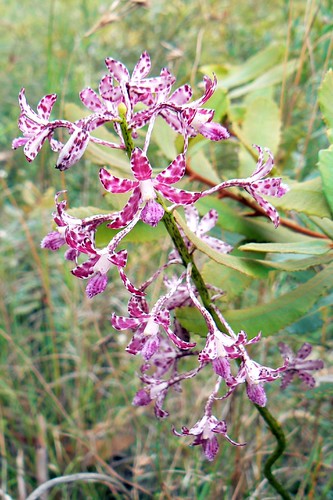
As I mentioned, I was the cook, so my botanising was limited although I managed to take some photos, some of which I'll be posting here over the next few days. The food went pretty well. I made a huge vegie curry, and a pesto pasta chicken salad, as well as more sandwiches than I thought humanly possible. The interns and staff didn't starve or die from food poisoning, so I guess it was successful!
I thought that rather than posting photos here in chronological order, I'd present them by family or location. To start with, some orchids. There were both Cryptostylis erecta and subulata about, but I've already posted images of those, so here are some others.
This delicate orchid, Genoplesium fimbriatum, or Fringed Midge Orchid, is far smaller than the image might suggest. The flower is only around a centimetre in diameter. It lacks leaves and is found only on the Australian East coast. Here is the entire plant:
A rather more showy orchid is this Dipodium sp., a Hyacinth Orchid.

Both these specimens were found at the Bulgandry Aboriginal Site in the Brisbane Waters National Park. Below is the boardwalk surrounding ancient Aboriginal rock carvings, including that of "Bulgandry Man". You can see images of the carvings here.
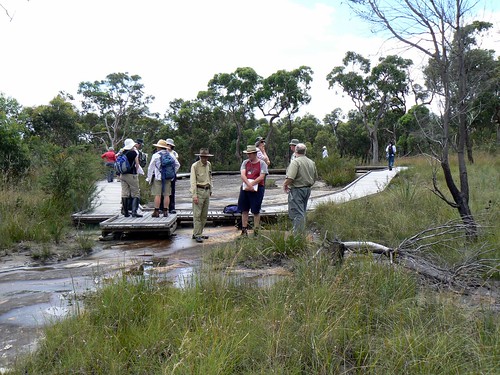

Actinotus minor, a smaller species in the same genus as the more famous Flannel Flower of which I've previously posted an image, is plentiful at this site. The flower is tiny, and only with close observation would you realise that it's very similar to its bigger cousin.
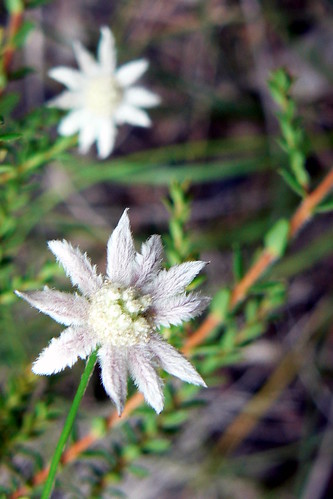

Finally, the moist sandstone heath of Bulgandry is home to this, the Drosera spatulata, a tiny carnivore. The sticky, spatulate leaves, catch small insects.
Friday, January 04, 2008
The Great Regeneration Project
There is a section of our front garden which some people might consider potential "lawn" (ugh, spit!) or just a big pile of weeds. But it holds treasures within. It's not so long since it was bushland, so the soil still contains seeds of the original flora either dormant or recently dispersed, and there are tiny seedlings struggling to find their way out of the invasive plants (both exotic and native) covering them.
Today, my friend from the Herbarium, Peta Hinton came for lunch and we spent the afternoon combing the garden looking for seedlings, and removing weeds around them to give them a chance. It'll be a long process, but with patience, we'll let the local flora return to its rightful place. Peta is a veteran bush regenerator and has bogglingly good skills at spotting and identifying native flora when it's barely past the cotyledon stage.
We found an amazing array of seedlings:
speciosissima (red Waratah). The other species I've planted
are mainly Allocasuarina spp, Eucalyptus spp, and Acmena smithii
(lillypillies). There remain some exotics, including Camellia. I'll
be removing them when their replacements are a little larger.
are mainly Allocasuarina spp, Eucalyptus spp, and Acmena smithii
(lillypillies). There remain some exotics, including Camellia. I'll
be removing them when their replacements are a little larger.
We found an amazing array of seedlings:
Proteaceae:
- Grevillea sericea
- Persoonia pinifolia
- Banksia oblongifolia
Fabaceae
- Acacia spp.
- Pultenaea daphnoides
- Angophora costata
- Kunzia ambigua
Asteraceae
- Ozothamnus diosmifolium
Euphorbiaceae
- Poranthera microphylla
Orchidaceae
- Cryptostylis subulata
- Cryptostylis erecta
Apiaceae
- Xanthosia pilosa
- Platysace linearifolia
On the upper left, are two seedlings close together. One is an
Angophora costata, the other an identified Acacia species.
On the right, a Grevillea sericea.
Angophora costata, the other an identified Acacia species.
On the right, a Grevillea sericea.
I knew that I had some more terrestrial orchids in the front yard, but until today, didn't know what they were. Now one's flowered and demonstrated itself to be Cryptostylis erecta. There are many yet to flower in this part of the garden, but I'm hoping that when they've got some space, they'll take off too. So now we've got two species of the Cryptostylis genus, this and the Cryptostylis subulata I posted about previously.
Subscribe to:
Posts (Atom)


